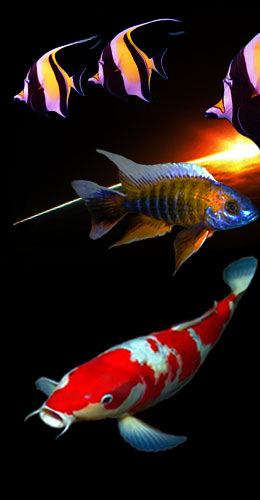CAUDAL PEDUNCLE DISEASE
This disease first progresses as a grey, patchy, discolored area on
the caudal peduncle (tail area). It almost appears as Columnaris disease or a
fungal disorder. Patchy, and fluffy in appearance.
Advanced stages may appear bloody, or the sloughing off of skin and
scales.
In the infected fish, the peduncle may darken, and as the disease
progresses, the caudal fin becomes frayed and eroded. In advanced
stages,
clinical signs of peduncle disease may include open
lesions and erosion of the
skin on the caudal peduncle, complete
erosion of the musculature of the tail, and loss of the caudal Fin.
Basically, the tail appears to have been eaten away.
Now they call this "cold water disease" in fish disease books, but
we have seen this disorder on fishes coming from warm waters (80
degrees fahrenheit). Certain fishes are more prone to the
disease, such as electric catfish, and other scaless fish.
The coldwater disease bacterium is a long, slender Gram-negative
rod. Its size
and morphology is similar to Flexibacter columnaris
which may also cause fin
erosion and tail rot signs. The
pathogen causes disease at low temperatures.
The disease may also be systemic. However, as is frequently the case
with columnaris disease, demonstration of the bacterium in tissues
other than the skin and muscle of the caudal peduncle may not be
possible.
Treatment and Control:
Raising water temperatures seems to help slow down the progression
of this disease. The two antibiotics of choice for treating
this disease are Doxycycline Hyclate, or Oxytetracycline
(Terramycin). A 14 day treatment at the elevated temperatures
is suggested, along with an anti-fungal treatment (Griseofulvin) to
prevent fungal spores from invading the wounds. Combine the
two ingredients and treat the fish once a week for two weeks
For Koi, you can also put the Doxycycline in the Koi Pellets and use
an antifungal treatment in the water. Anti-Fungal treatments
may include: Forma-Green, -or- Acriflavine -or- Griseofulvin.
Many times the damage to the tail is so severe, that it will never
grow back. In the case of our electric catfish, this is what
happened. The fish survived for many years after the
treatment, but had some problems swimming due to a missing tail fin.
Best regards,
Dr. Brian G. Aukes; PhD.
Chief Pathologist, National Fish
Pharmaceuticals
|










